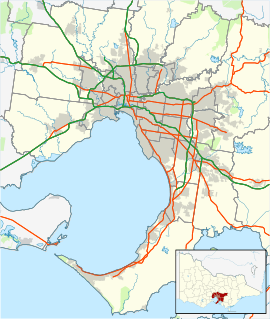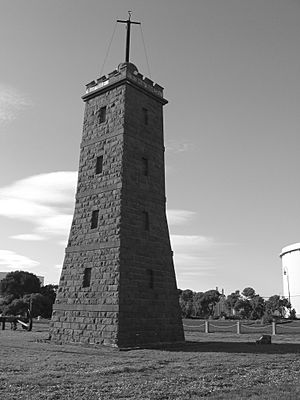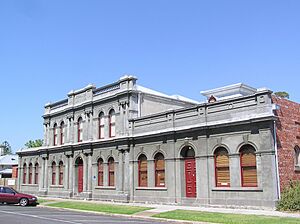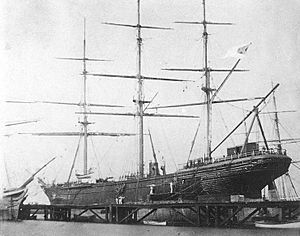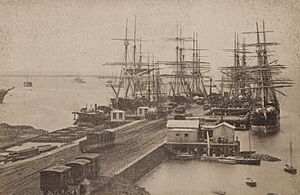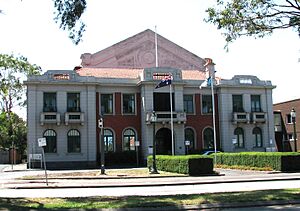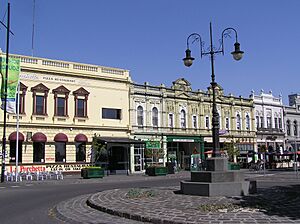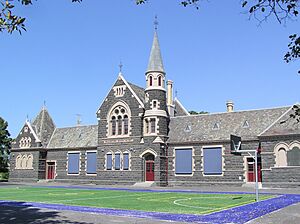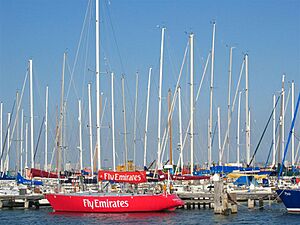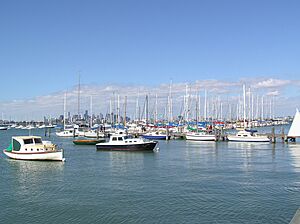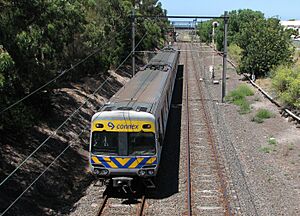Williamstown, Victoria facts for kids
Quick facts for kids WilliamstownMelbourne, Victoria |
|||||||||||||||
|---|---|---|---|---|---|---|---|---|---|---|---|---|---|---|---|
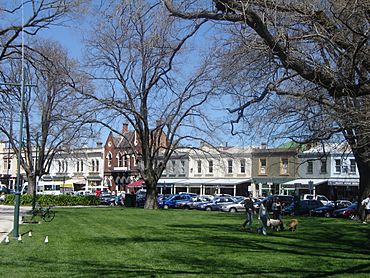
Nelson Place, in the restaurant precinct
|
|||||||||||||||
| Population | 14,407 (2021 census) | ||||||||||||||
| • Density | 2,619/km2 (6,780/sq mi) | ||||||||||||||
| Postcode(s) | 3016 | ||||||||||||||
| Elevation | 12 m (39 ft) | ||||||||||||||
| Area | 5.5 km2 (2.1 sq mi) | ||||||||||||||
| Location | 11 km (7 mi) from Melbourne CBD | ||||||||||||||
| LGA(s) | City of Hobsons Bay | ||||||||||||||
| State electorate(s) | Williamstown | ||||||||||||||
| Federal Division(s) | Gellibrand | ||||||||||||||
|
|||||||||||||||
Williamstown is a suburb located in Melbourne, Victoria, Australia. It's about 11 kilometers south-west of Melbourne's main city center. This area is part of the City of Hobsons Bay local government area. In 2021, about 14,407 people lived in Williamstown.
Contents
Discovering Williamstown's Past
Who Lived Here First?
Long before European settlers arrived, Indigenous Australians called this land home. The Yalukit-willam clan of the Kulin nation were the first people to live around Hobsons Bay. They moved along the coast from Werribee to Williamstown.
The Yalukit-willam were part of a larger group called the Bunurong. This group had six clans living along the coast. They stretched from the Werribee River to Wilsons Promontory.
The Yalukit-willam people had a special name for the Williamstown area. They called it "koort-boork-boork." This means "clump of she-oaks," or "many she-oaks."
How Williamstown Began
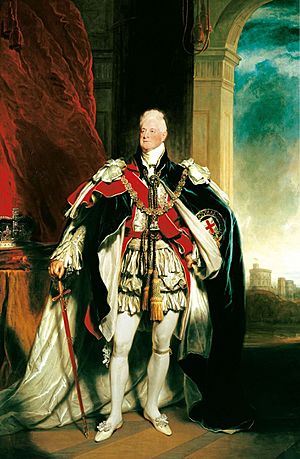
In 1835, Captain Robson Coltish sailed from Launceston. He brought 500 sheep and 50 Hereford cattle across Bass Strait. He chose the area now known as Port Gellibrand to unload his animals.
In 1837, Governor Richard Bourke and Captain William Lonsdale visited the new settlement. They thought the main town would grow at Point Gellibrand. They named it William's Town after King William IV, who was the English monarch at the time.
Williamstown was the first main port for the Port Phillip settlement. It was considered as a possible capital city. However, Melbourne was chosen instead because it had more fresh water. Even so, Williamstown remained a very important port. Its first streets were planned in 1837.
The first land was sold here in 1837. A 30-meter stone jetty was built by convict workers in 1838. This is where Gem Pier stands today. A ferry service also started in 1838. It carried people and animals between Melbourne and Williamstown.
The first lighthouse was built in 1840 at Point Gellibrand. It was made of wood and used an oil lamp. In the same year, water police started working in Williamstown. Today, Williamstown is still home to the Victorian Water Police.
A stronger lighthouse made of bluestone was built in 1849–50. It stopped being a lighthouse in 1860. After that, it was used as a time ball tower. A time ball would drop at a certain time each day to help ships set their clocks.
The Gold Rush and Growth
Williamstown was a small settlement until the Victorian gold rush began in the 1850s. Many gold seekers arrived, and the town grew very quickly. The first Williamstown Post Office opened in 1850.
Australia's first telegraph line started in 1854. It connected Melbourne and Williamstown. The timeball was moved to the Telegraph Station at Point Gellibrand. The Williamstown Chronicle, Victoria's first suburban newspaper, also started in 1854.
Fort Gellibrand was built in 1855. This was during the Crimean War, to protect against a possible Russian attack.
The Williamstown Post Office, which is the oldest post office building still standing in Victoria, was built in 1860. A Mechanics' Institute was also built that year. By 1861, Williamstown had many places for boat repairs. The town's boundaries grew in 1864 to include Newport and Spottiswoode (now Spotswood).
Piped water from Yan Yean arrived, helping the town grow even faster. The Williamstown Racing Club started in 1864. The Williamstown Racecourse was considered one of Australia's best. The Williamstown Football Club, an Australian rules football club, was also formed in 1864.
The CSS Shenandoah Incident
In 1865, a warship from the Confederate States Navy called CSS Shenandoah sailed into Hobsons Bay. This ship had attacked several Union ships in the Indian Ocean.
Later, in 1871, an international court decided that Britain had to pay damages to the US government. This was because the CSS Shenandoah had used the port at Williamstown.
Williamstown as a Major Port
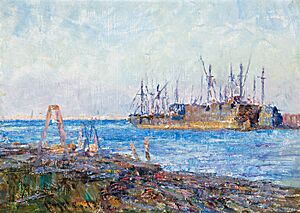
From 1857 to 1889, the main railway workshops for the Victorian Railways were at Point Gellibrand. They covered a large part of the area. Imported steam locomotives were put together here. In 1889, these workshops moved to nearby Newport.
The Alfred Graving Dock is a very important historical site. It was the first dry dock in Victoria and the third in Australia. It helped the shipping industry grow in Port Phillip.
The Royal Yacht Club of Victoria moved to its current location in 1873. It is next to Gem Pier. Williamstown North Primary School opened in 1874. The Williamstown Primary School No. 1183 also opened that year.
The Williamstown CYMS football club was formed in 1886. It is one of Australia's oldest sports clubs. The Hobsons Bay Yacht Club is also located on Nelson Place. The Williamstown Hospital opened in 1894. It was Melbourne's first suburban public hospital.
The Williamstown Lacrosse Club was founded in 1898.
Williamstown in the 20th Century
Williamstown Pier railway station opened in 1905. It mainly served the docks. In 1906, a large ship, SS Peregrine, was made longer by 40 feet at the Williamstown Dockyard. This was one of the first times such a big ship repair was done in Australia.
The Williamstown Hospital was expanded in 1911 and 1917. Artists like Walter Withers and Frederick McCubbin painted many scenes of Williamstown around 1910-1915. They captured the foreshore and shipyards.
Williamstown became a City on May 17, 1919. The Williamstown Town Hall started being built in 1918 and opened in 1927.
In 1934, the bluestone time ball tower (the old lighthouse) was made taller. It became a lighthouse again until 1987. It had electric green and red lights.
The Williamstown Little Theatre Movement started in 1946. They moved into their current home, a converted bakery, in 1967. It is now one of Melbourne's leading non-professional theatre groups.
In 1948, Williamstown became part of a new Australian Federal electoral area. It was called the Division of Gellibrand. The destroyer HMAS Anzac was put into service at Williamstown Naval Dockyard in 1951.
The Merrett Rifle Range in Williamstown was used for rifle shooting during the 1956 Summer Olympics. In 1976, the Pile Light, which had been anchored off Shelly Beach since 1860, was destroyed when a large ship hit it.
Later, 60 hectares of land were developed for housing and businesses. The historic armoury building from the old rifle range was saved and is now a funeral home. The remaining 50 hectares became the Jawbone Flora and Fauna Reserve. This area protects grasslands, wetlands, and mangrove areas.
How Williamstown is Governed
Williamstown is part of the Victorian electoral district of Williamstown. This means people in Williamstown vote for a representative in the state government. In 2007, Wade Noonan became the representative. He kept the seat in the 2010 and 2014 State Elections.
Important Buildings and Places
Williamstown has many heritage buildings and sites. These are important historical places that are protected.
Schools in Williamstown
There are several primary schools in Williamstown:
- St. Mary's Primary School
- Williamstown Primary School
- Williamstown North Primary School
For high school, students can attend:
- Bayside Secondary College
- Williamstown High School (Pasco and Bayview Street Campuses)
The Junior School of Westbourne Grammar School is also in Williamstown. It is located in a beautiful old mansion called "Monomeith."
Places of Worship
Williamstown has many churches:
- St Mary's Catholic Church (Cecil Street)
- St Andrew's Presbyterian Church (Cecil Street)
- Holy Trinity Anglican Church (Nelson Place)
- St John's Uniting Church (Electra Street)
- Williamstown Gospel Mission Church (Electra Street)
- St Stephen's Uniting Church (179 Melbourne Road)
- Westgate Vineyard Church (57 Stevedore Street)
- Church of Christ (Douglas Parade)
Williamstown's Economy
Williamstown has a strong connection to its maritime history. The piers are home to large maritime industries. Nelson Place is a popular area for tourism.
BAE Systems Australia's Marine division works at the Williamstown dockyards. They have built ships for the Royal Australian Navy.
Williamstown is still a working port. The Point Gellibrand fuel terminal helps supply fuel.
Nelson Place has many restaurants and cafes, often with outdoor dining. You can also find unique arts, crafts, and specialty shops there.
Other local shops are on Ferguson Street and Douglas Parade. These streets have a mix of restaurants, cafes, hotels, and retail stores.
In Williamstown North, there is still a railway engineering industry. There is also a light-industrial and commercial park.
Culture and Arts in Williamstown
The Williamstown Festival is a big community event held every year in March/April. It celebrates the culture of Melbourne's Western Region.
The Williamstown Literary Festival is held in May. It focuses on books, plays, and writing. It features both well-known and new writers.
You can visit a maritime museum on board the World War II minesweeping corvette HMAS Castlemaine. It is docked at Gem Pier.
Williamstown Little Theatre has been open since 1946. It is one of the top non-professional theatre companies in Melbourne.
Williamstown has also been used as a filming location for Australian TV shows, like The Henderson Kids.
Sports and Recreation
Williamstown has a strong maritime feel. This is due to the Williamstown Lighthouse, the ship building yard, and the many yachts in Hobsons Bay. Several yacht clubs are located on Nelson Place:
- Williamstown Sailing Club
- Royal Yacht Club of Victoria
- Hobson's Bay Yacht Club
- Royal Victorian Motor Yacht Club
The Williamstown Seagulls are a semi-professional Victorian Football League team. They play at Burbank Oval. They have won many championships.
Williamstown CYMS Football Club is an amateur football club. It was formed in 1886.
The Williamstown Juniors Football Club has many teams for younger players. Famous AFL players like Daniel Giansiracusa and Ben Davies played here.
Williamstown Cricket Club is one of Victoria's oldest, running since 1852. They have senior, women's, and junior teams.
The Williamstown Wolves Baseball Club started in 1908. They play at Greenwich Reserve.
The Williamstown Magic Basketball Club and Williamstown Cannons Basketball Club have many junior teams.
Williamstown also has a local soccer club, Williamstown SC. It was started in 1981.
Lacrosse is also popular in Williamstown. Three clubs use Fearon Reserve:
- Williamstown Lacrosse Club
- Williamstown Women's Lacrosse Club
- Newport Ladies Lacrosse club
For the 1956 Summer Olympics, Williamstown hosted the shooting events.
Famous tennis player Mark Philippoussis grew up in Williamstown. Other sports stars, like AFL players Chris Grant and Rohan Smith, also live here.
The Hobsons Bay Coastal Trail runs through Williamstown. It is popular for walking and running.
Scouts Australia has a Sea Scout and a Scout group in Williamstown.
Getting Around Williamstown
Williamstown is about a 15-minute drive from Melbourne. You can also take a 30-minute train ride from Flinders Street station. Ferries from Melbourne's Southgate take about an hour.
Williamstown has three train stations on the Williamstown railway line:
- North Williamstown
- Williamstown Beach
- Williamstown
There are also three bus routes that connect Williamstown to nearby suburbs.
Main roads from Williamstown include Kororoit Creek Road, which goes towards Altona and Laverton. Douglas Parade and Melbourne Road head north to Newport and Spotswood. Melbourne Road connects to central Melbourne via the West Gate Bridge.
A ferry service connects Williamstown's Gem Pier to St Kilda and Port Melbourne. It runs daily during busy seasons.
Well-Known People from Williamstown
Many notable people have lived in Williamstown, including:
- Steve Bracks AC, a former Premier of Victoria
- Bill Deller OAM, a former Australian rules football umpire
- Tony Dodemaide, a cricketer
- Andy Griffiths, a famous author
- Brad Johnson, a Western Bulldogs football captain
- Shaun Micallef, a comedian and TV presenter
- Mark Philippoussis, a tennis player
- Mark Viduka, a soccer player and former Socceroos Captain
- Scott West, a Western Bulldogs footballer
Images for kids
-
St. Andrew's Presbyterian Church (Built 1870)
-
West Gate Bridge (seen from Williamstown)


